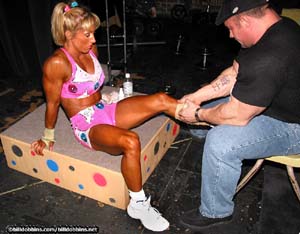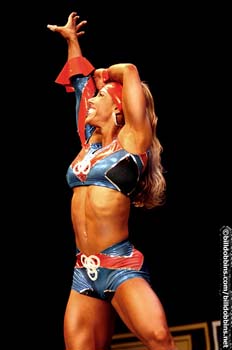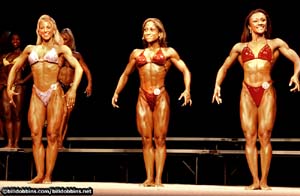GYMNASTICS: THE ACHILLES HEEL (OR SPRAINED ANKLE) OF FITNESS
(click on pictures for
larger images)
By Bill Dobbins
There were at least two casualties of the fitness performance round at the 2002 Jan Tana. Kelly Ryan, a Bela Karolyi trained gymnast, did her routine on a damaged calf muscle and damaged it even further. Laura Makowski, another excellent gymnast, sprained her ankle and had to withdraw from the competition. Fortunately, neither of these injuries were career ending or life threatening. But as fitness is now being conducted both of those possibilities seem all too likely in the future - if not inevitable.
| Craig Titus tapes up Kelly Ryan's injured calf. |
"I hurt my calf training for the show," Kelly reports. "The problem is doing gymnastics on a wood floor instead of a mat - plus the fact that I was dehydrated and had low body fat to look hard and defined. When you do gymnastics competitions you are on a mat, not a hard floor and you don't have to deplete your body the way you do for fitness. For the Jan Tana, I taped up my calf and used a lot of heat therapy so I got through the routines. But I ended up making the injury even worse, as you would expect."
Unfortunately, whatever fitness was intended to be in the eyes of the NPC and IFBB it has become essentially a gymnastics event. If you haven't trained as a gymnast since you were a child, you don't have much of a chance. Even the physique rounds seem to be influenced by the gymnastics model. The winners tend to be small and wiry, without a lot of either bodybuilding fullness of shape nor a more coventional voluptuousness - with several notable exceptions, of course. Nor are the winners selected for the most part with any regard to exeptional facial beauty - the kind of looks, for example, that would cause them to be selected as cover models for magazines like Muscle & Fitness, Muscle Mag or Iron Man. So the winners tend not to have exceptional physiques (although the events are sanctioned by bodybulding organizations) nor are they usually beautiful enough to have the kind of widespread appeal that would give them value as models in the fitness industry.
Actually, Kelly Ryan is something of an exception to the rule in that she has taken a gymnast's body and added a considerable amount of muscle size, shape and definition. Most fitness competitors are trying to go the opposite way, since "she looks like a bodybuilder" is the kiss of death when it comes to fitness judging - even when the individual being described that way is much too small and smooth to be competitive in a bodybuilding contest.
If you look at the history of fitness, it started out having nothing whatsoever to do with what we think of as "physique." Promoter Wally Boyco began holding fitness contests at his fitness industry trade shows. He invited exhibitors to sponsor women to enter what was essentially a beauty contest for young women in good shape. Boyco then discovered the financial potential of syndicated television and the "Ms. Fitness" (he owns that name) competition was born . But to fill up an hour of TV time Boyco needed some kind of entertaining performances. Many of the women who entered his contests were gymnasts and their ability set the tone for the Ms. Fitness performance round - and, as it turned out, fitness contests in general - from then on.
| Laura Mak was forced to withdraw from the 2002 Jan Tana with an injured ankle. |
There was and still is no real "muscle" in a Ms. Fitness contest. Nor is there necessarily much of a ticket-buying audience. Since Ms.Fitness is filmed as a TV show and that's where the money comes from, all Wally Boyco needs is enough bodies in the theater to make it look good on television.
Lou Zwick, who produces shows in conjunction with ESPN, liked the idea and essentially decided to follow Boyco's model. The "Fitness America" series differs from the Ms. Fitness shows in at least two ways: While Zwick does not like female muscle very much, there have been women with at least some muscularity who have done well in his contests. Also, since there is very little money in cable TV compared to syndication, Zwick allows as many as 110 or 120 competitors into the contest, all of whom pay a fee to compete and who bring friends, family, boyfriends and husbands along to buy tickets and fill up the audience. But the performance round of the Fitness America contests continues to be based on ability to do gymnastics. Both Boyco and Zwick have found it makes good television.
The NPC decided to sanction fitness because they saw that the Ms. Fitness and Fitness America contests were having some success. The NPC is essentially an organization of promoters, and those promoters want as many bodies on stage as they can get and as many ticket buyers as possible. If there was an audience for fitness, they reasoned, let's do it. But nobody seems to have given a lot of thought to considering whether the Boyco-Zwick model - designed to produce a television show - was appropriate to a physique federation whose history was that of bodybuilding promotion. The NPC could have created a series that was, in a sense "soft" bodybuilding, involving women who combined some degree of muscle with a lot of conventional beauty - and they could have included a performance round that contributed points to an overall score but which would have been much less of a factor than beauty of physique and face.
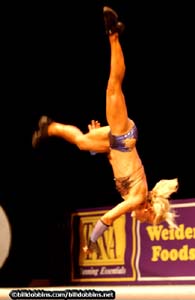 But
they didn't. Instead, the federation followed the "established"model
almost exactly, including both the discouragement of too much muscle development
and reliance on a performance round that quickly became dominated by gymnasts.
Soon after the IFBB followed suit, although the IFBB policy was so anti-muscle
that many NPC Fitness Nationals winners found themselves too muscular to
be successful as a pro. Irony is lost on some people.
But
they didn't. Instead, the federation followed the "established"model
almost exactly, including both the discouragement of too much muscle development
and reliance on a performance round that quickly became dominated by gymnasts.
Soon after the IFBB followed suit, although the IFBB policy was so anti-muscle
that many NPC Fitness Nationals winners found themselves too muscular to
be successful as a pro. Irony is lost on some people.
The result of this policy has been - for both the NPC and the IFBB - the creation of champions who might be great people, not unattractive, wonderful athletes or whatever, but are USUALLY NOT VERY PROMOTABLE. They don't end up with lucrative, long running contracts with sponsors. They aren't featured on magazine covers. They do not attract crowds of people to a booth at the Olympia or Arnold Expos. These "champions" in general can't make much money for themselves or the industry. So you have to wonder whether fitness as now conducted in the NPC/IFBB is missing the point. After all, there are already gymnastics contests. Why should physique federations be staging them as well?
And, of course, there is the danger. Many of these young women were competitive gymnasts as teenagers. But they aren't teenagers anymore. They are older and heavier, they have more muscle so their strength-to-weight ratio is not ideal. The former gymnasts all have chronic aches, pains and injuries developed over many years of wear and tear on their bodies. Doing gymnastics when older, especially on a wood floor instead of mats, is not doing their bodies any good.
Many others never were gymnasts but have to try to do gymnastics
moves in order to have a chance of placing well. Are you a great 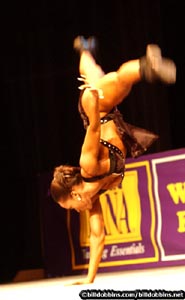 dancer?
That won't get you far in NPC/IFBB fitness. A martial artist, track champion,
world-class water skier? Sorry, that won't count for much. But non-gymnasts
trying to learn gymnastics later in life are even more prone to accident or
injury. Women have broken their legs practicing their routines. A couple have
landed on their heads or necks - although thankfully no permanent injury resulted.
Bunches of them have had to quit in the middle of contests due to injury -
like Laura Mak at the Jan Tana.
dancer?
That won't get you far in NPC/IFBB fitness. A martial artist, track champion,
world-class water skier? Sorry, that won't count for much. But non-gymnasts
trying to learn gymnastics later in life are even more prone to accident or
injury. Women have broken their legs practicing their routines. A couple have
landed on their heads or necks - although thankfully no permanent injury resulted.
Bunches of them have had to quit in the middle of contests due to injury -
like Laura Mak at the Jan Tana.
When Monica Brant appears at an Expo, there is a long line to get photos of her. Timea Mayorova's sleek and sexy look has attracted fans from all over the world. Debbie Kruck, who was once placed last in the physique round of a fitness contest (!!!) is one of the busiest and most sought after fitness models in the world. All of these women are stars. None are gymnasts. And none could win a contemporary fitness championship - which is why none compete any more.
To compound the whole problem of fitness, the NPC is now sanctioning "figure" - which is nothing more than somewhat fit women doing quarter turns on stage wearing two piece and one piece suits. This gets bodies on stage and in the audience, but at what cost? As it is, fitness at the local level is quickly dying, with perhaps 5 fitness women in a show while there are 55 or more in figure. Why should women work to develop difficult and dangerous routines - especially if they aren't trained gymnasts - when they can just go up on stage and do quarter turns? Enter the contest, in addition, without a lot of effort put into training and diet to develop an impressive physique ("physique" being the middle term in the title "National Physique Committe").
Jan Tana 2 piece round: Julie Palmer - 7th/ Alti Batista - 1st /Tanji Johnson - 3rd |
There are still plenty of fitness women at the national and pro levels. In fact, the federations qualify huge numbers of fitness women as pros compared to female bodybuilders. Apparently the philosophy is that fitness competitors are so expendable there is no such thing as having too many of them.
But aside from the question of whether allowing fitness to be dominated by highly trained gymnasts, with little regard to "physique" or overall promotability, the question of danger remains. Some day, on stage or in training, some fitness competitor is going to hurt herself badly and the federation involved will be subject to a major lawsuit for not making the competitions safer (providing mats and/or limiting the gymnastics allowed). Can you imagine a little fitness girl paralyzed, unable to walk and being brought into court in a wheelchair, wearing a neck brace, while the federation lawyer says to the jury, "Well, she signed a waiver...." Signed a waiver???
So what course of action should the federations take? Here are a few suggestions:
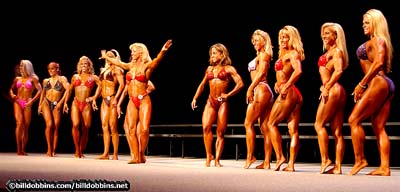 |
Fitness - The muscular or the voluptuous need
not apply. |
1. Change the judging rules of fitness so as to produce "supermodels" for the fitness industry, champions who can appear on magazine covers and sell products for sponsors through advertising and expo appearances.
2. Put more emphasis on PHYSIQUE and award points for bodies that have real muscle and definition but are not so developed that they don't retain convential beauty and appeal. After all, this is the age of Serena Williams and Marion Jones, of movie stars Linda Hamiliton and Angela Bassette, of pop stars like Madonna with her developed biceps and a whole host of MTV girls with well defined abs. Why should the physique federations be so far behind the times?
3. Limit the amount of gymnastics permitted in the routines, no tumbling for example, and have the routine count for a smaller percentage of the overall score awarded a competitor. Remind the judges that the "performance" round is intended to show athleticism and grace - and to give credit when officiating for physical skills such as dance, strength and agility rather than focusing only on gymnastics ability (a dancer, for example, can win the performance round in a Ms. Fitness or Fitness America contest).
As to "figure," there is not much to recommend. If the federations have so little respect for female physique, dislike muscular women to such a degree (or think the audience does) and are determined to include a beauty contest in their events, then why don't they just call it a beauty contest, a model search or something else that indicates they know what kind of a competition it really is. And try to come up with something other than boring quarter turns. If your wife or girlfriend is in the show, you no doubt find it interesting. Most of the rest of the audience does not.
.
